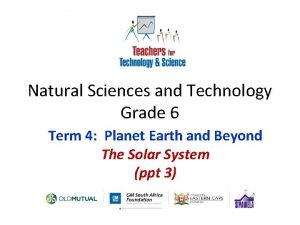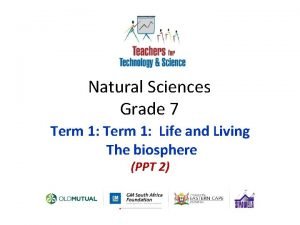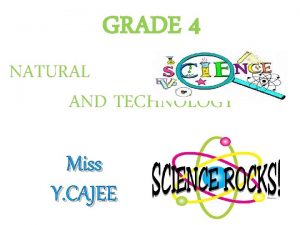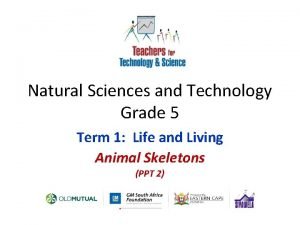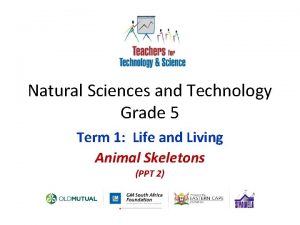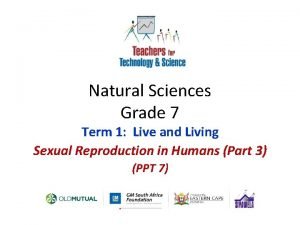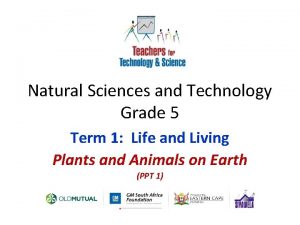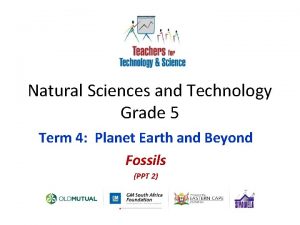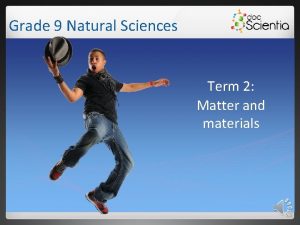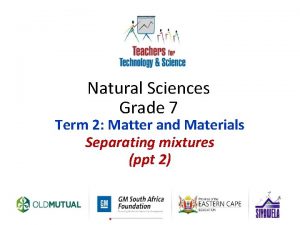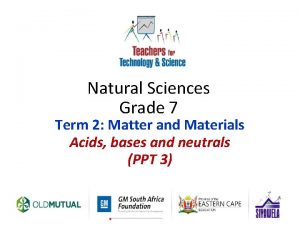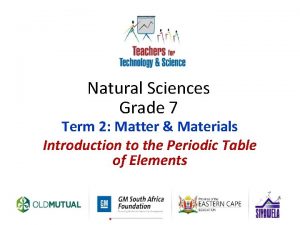Natural Sciences Grade 7 Term 2 Matter and




![Physical properties of materials Material Strength [1] • Strong materials, such as steel and Physical properties of materials Material Strength [1] • Strong materials, such as steel and](https://slidetodoc.com/presentation_image_h2/848871243e6600c98c4e0c406d5a500b/image-5.jpg)
![Physical properties of materials Material Strength [2] • Doors and tables are often made Physical properties of materials Material Strength [2] • Doors and tables are often made](https://slidetodoc.com/presentation_image_h2/848871243e6600c98c4e0c406d5a500b/image-6.jpg)











- Slides: 17

Natural Sciences Grade 7 Term 2: Matter and Materials Properties of materials (ppt 1)

Topic 1 Properties of materials Physical properties of materials Natural Sciences - Grade 7

Physical properties of materials • Humans use a variety of materials in their day to day life. • These products are made from different materials, such as metal, glass, wood, plastics, rubber, etc. • We need to understand the physical properties of the materials so that we can decide whether to use it for a specific purpose. Natural Sciences - Grade 7

Physical properties of materials • Some physical properties that need to be considered for use are: strength, flexibility, heat conductivity, electrical conductivity, etc. • Other considerations can be boiling point and melting point of a substance. • Would you make shoes from wood or a car body from plastic? Natural Sciences - Grade 7
![Physical properties of materials Material Strength 1 Strong materials such as steel and Physical properties of materials Material Strength [1] • Strong materials, such as steel and](https://slidetodoc.com/presentation_image_h2/848871243e6600c98c4e0c406d5a500b/image-5.jpg)
Physical properties of materials Material Strength [1] • Strong materials, such as steel and concrete, are used in the construction of structures that must withstand great pressure without breaking. A very heavy train, as well as cars, must be able to pass over the suspension bridge. Natural Sciences - Grade 7
![Physical properties of materials Material Strength 2 Doors and tables are often made Physical properties of materials Material Strength [2] • Doors and tables are often made](https://slidetodoc.com/presentation_image_h2/848871243e6600c98c4e0c406d5a500b/image-6.jpg)
Physical properties of materials Material Strength [2] • Doors and tables are often made from strong wood. • Window frames are made from steel and aluminium. • The materials used to construct dams, bridges, doors and window frames must be both strong and rigid. • The gymnast in the picture is balancing on a wooden beam that is strong and rigid. Natural Sciences - Grade 7

Physical properties of materials Flexibility • The opposite of rigid, is a flexible material that is easy to bend. • Some materials need to be flexible, e. g. soles of shoes; copper wire used to make conducting wire; tyres of vehicles; etc. • Glass is a rigid material that is used as window panes. • A helmet that is used to protect your head, also has to be rigid. Natural Sciences - Grade 7

Boiling points and melting points • Matter occurs in three physical states, i. e. solids, liquids and gases. • Heat is added or removed from a substance to change from one phase to another. • Melting point – heat added to a solid to change to liquid state. Some melting points: Water: 0°C Ethanol: -114°C Candle wax: 50°C Iron: 1538°C • Strong materials generally have very high melting points. Natural Sciences - Grade 7

Boiling points and melting points • Water that is heated, boils eventually at approximately (conditions vary) 100°C and it is called the boiling point of water. • The difference in the melting and boiling points of water, is due to the impurities of chemicals, as well as the air pressure. (e. g. In Johannesburg, where the air pressure is lower, the water will boil at 96°C. Some boiling points: Water: 100°C Candle wax: 300°C Ethanol: 78 °C Iron: 2 862°C Natural Sciences - Grade 7

Electrical conductivity • Electrical conductors allow electricity to move very easily through it. • Electrical wiring is made from specific materials, namely aluminium and copper. • Insulators do not allow electricity to move through it. • Can you remember what materials are used to make insulators? Natural Sciences - Grade 7

Heat conductivity • The ability of a material to conduct heat, is called heat conductivity. • Examples: cooking pots / pans (copper / aluminium / stainless steel pot). • Pot handles must not conduct heat, otherwise you will burn when you remove the pot from the heat source. Natural Sciences - Grade 7

Heat conductivity • Handles are mostly made from plastic or wood which are good thermal insulators. • Thermal insulation materials are more expensive than expanded polystyrene. Natural Sciences - Grade 7

Other factors to think about when using materials to make things Cost Consider cost when a product is designed (more plastic bottles are used for cold drinks than glass bottles). Also think of the life cycle cost (product’s maintenance and repair). Natural Sciences - Grade 7

Other factors to think about when using materials to make things Style The things must look attractive; have comfortable patterns and fittings; long/short/no sleeves; collar/no collar; buttons, zip; must be fashionable, yet practical. Natural Sciences - Grade 7

Other factors to think about when using materials to make things Appearance Does it appear to be: - cheap/expensive - formal/ informal - glossy/ casual; - dependant on the lighting Natural Sciences - Grade 7

Other factors to think about when using materials to make things Colour It improves the recognition of objects; speeds up the visual search; enhances its meaning; establishes its identity; improves usability; communicates the mood (bright / dark/ dull/ colours); affects how cold/hot the material gets (light colours – reflect the rays of the sun and results in staying cool ; dark colours – absorb the rays of the sun and results in the material becoming hotter. Natural Sciences - Grade 7

Other factors to think about when using materials to make things Texture refers to how the material feels when it is touched: It can be weak, moderate or strong; is seen in most engineered materials; should feel comfortable on the body, e. g. blanket / jersey/etc. ; should feel smooth when used for eating/dishing, e. g. spoon/ fork. Natural Sciences - Grade 7
 Grade 6 term 4 natural science
Grade 6 term 4 natural science Matter and materials grade 6
Matter and materials grade 6 Life and living grade 7 resources
Life and living grade 7 resources Natural science grade 7 term 4
Natural science grade 7 term 4 Social science grade 7 term 3
Social science grade 7 term 3 Grade 7 ns term 2 worksheets
Grade 7 ns term 2 worksheets Natural science grade 7 term 3
Natural science grade 7 term 3 The human sciences tok
The human sciences tok Grade 6 ecosystems
Grade 6 ecosystems Natural science and technology grade 6 lesson plans term 4
Natural science and technology grade 6 lesson plans term 4 Grade 4 nst term 3 practical task
Grade 4 nst term 3 practical task Grade 5 social science term 1
Grade 5 social science term 1 Animal skeletons grade 5
Animal skeletons grade 5 Natural science grade 7 term 3 notes
Natural science grade 7 term 3 notes Grade 5 natural science term 1
Grade 5 natural science term 1 Natural science grade 6 term 3 electricity
Natural science grade 6 term 3 electricity Grade 5 natural science term 4
Grade 5 natural science term 4 Energy transfer to surroundings grade 7
Energy transfer to surroundings grade 7
